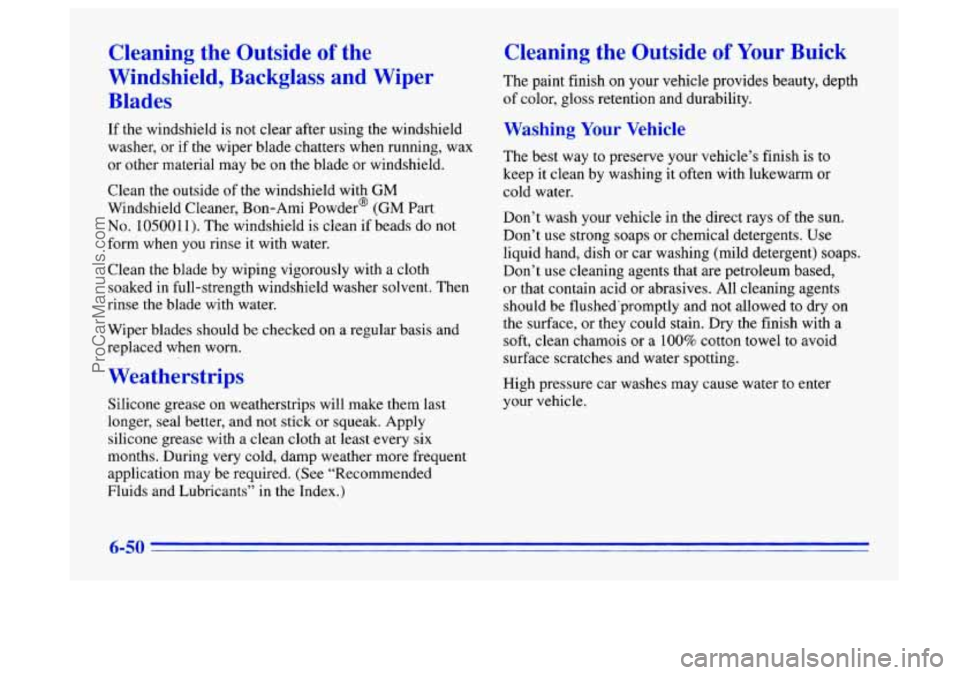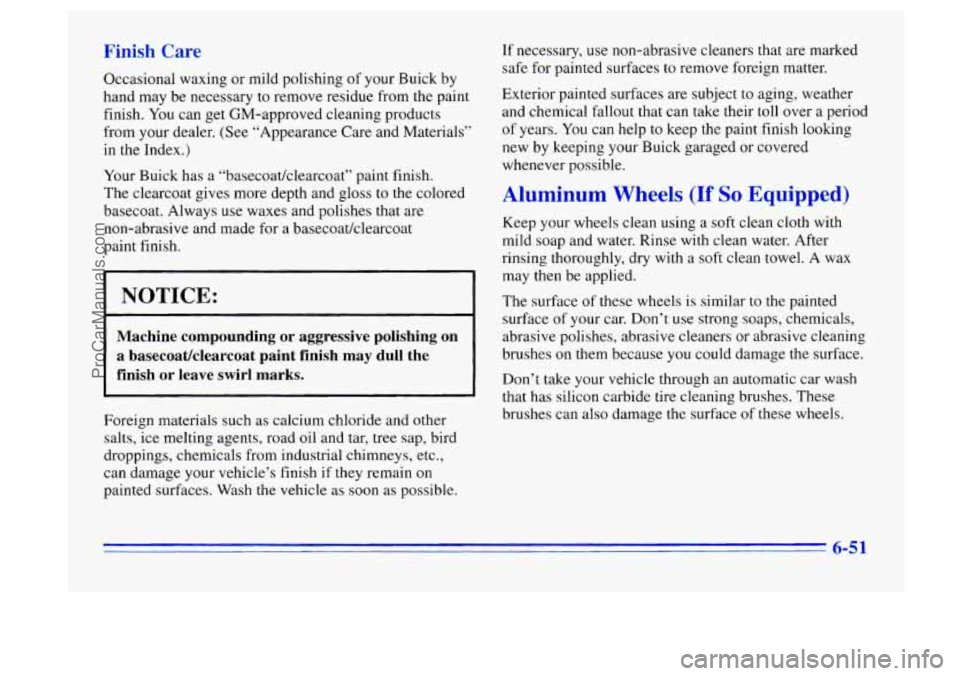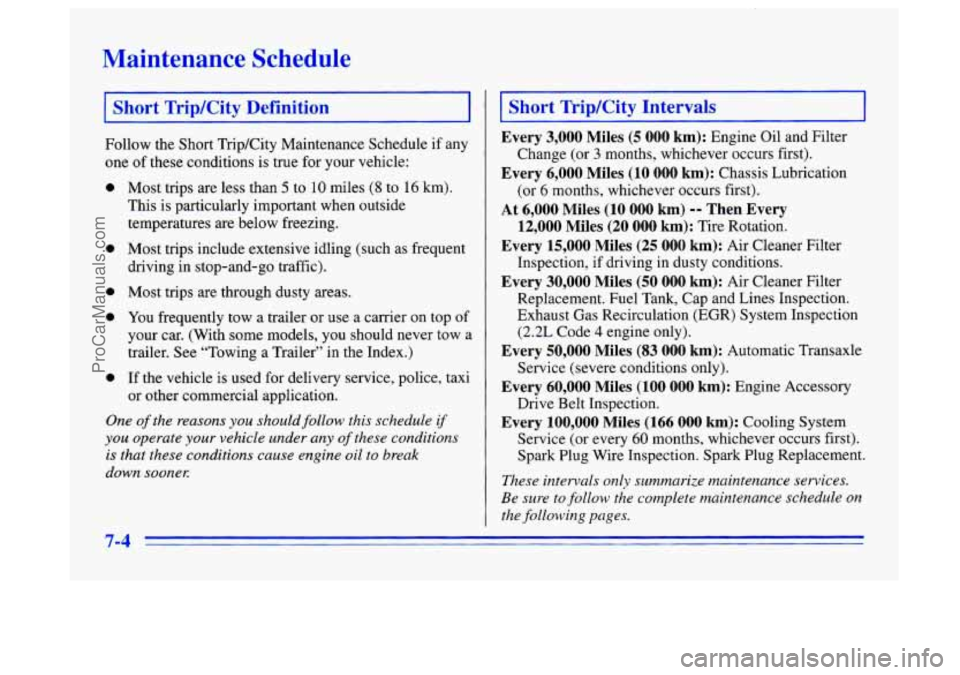Page 225 of 340
3.1L V6 Engine
The transaxle fluid dipstick handle is red and looks
like this.
1. Pullout the dipstick and wipe it clean with a clean
rag or paper towel.
2.2L L4 Engine
2. Push it back in all the way, wait three seconds and
then pull
it back out again.
6-19
ProCarManuals.com
Page 240 of 340
To replace the bulb
assembly:
1. Snap a new bulb into the wiring harness (A). Make
sure the locking tab
(B) is over the lock (C).
2. Install the bulb assembly by putting the small tab (D)
in the small notch in the retainer ring (E).
in place.
3. Turn the bulb assembly 1/6 turn clockwise to lock it
Front lhrn and Parking Bulb and/or
Sidemarker
Bulb Replacement
1. Raise the hood.
2. Insert a screwdriver into the loop of the spring,
which can be seen just behind the bulb assembly.
3. Pull the spring to the rear and slightly toward the
outside
of the vehicle until the detent releases from
the notch in the headlamp mounting frame.
6-34
ProCarManuals.com
Page 246 of 340

Tire Inspection and Rotation
Tires should be inspected every 6,000 to 8,000 miles
(10 000 to 13 000 km) for any signs of unusual wear.
If unusual wear is present, rotate your tires as soon as
possible and check wheel alignment. Also check for
damaged tires or wheels. See “When It’s Time for
New
Tires” and “Wheel Replacement” later in this section for
more information. When
rotating your tires, always
use the correct rotation
pattern shown here.
Don’t include the compact spare tire in your tire rotation,
After the tires have been rotated, adjust the front and
rear inflation pressures as shown on the Tire-Loading
Information label. Make certain that all wheel nuts are
properly tightened. See “Wheel Nut Torque”
in
the Index.
The purpose
of regular rotation is to achieve more
uniform wear for all tires
on the vehicle. The first
rotation
is the most important. See “Scheduled
Maintenance Services”
in the Index for scheduled
rotation intervals.
1 A CAUTION:
Rust or dirt on a wheel, or on the parts to which
it is fastened, can make wheel nuts become loose
after
a time. The wheel could come off and cause
an accident. When
you change a wheel, remove
any rust or dirt from places where the wheel
attaches to the vehicle. In an emergency, you can
use
a cloth or a paper towel to do this; but be
sure to use
a scraper or wire brush later, if you
need to, to get all the rust or dirt
off. (See
“Changing a
Flat Tire” in the Index.)
6-40
ProCarManuals.com
Page 253 of 340

If a ring forms after spot cleaning, clean the entire
area immediately or it will set.
Usin - lam-npe Cleanel- -In
1.
2.
3.
4.
5.
6.
7.
8.
9.
10.
11.
hcuum and brush the area to remove any loose
dirt.
Always clean a whole trim panel or section. Mask
surrounding trim along stitch or welt lines.
Mix Multi-Purpose Powdered Cleaner following
the directions on the container label.
Use suds only and apply with a clean sponge.
Don’t saturate the material.
Don’t rub it roughly.
As soon as you’ve cleaned the section, use a sponge
to remove the suds.
Rinse the section with
a clean, wet sponge.
Wipe off what’s left with a slightly damp paper
towel or cloth.
Then dry it immediately with a blow dryer.
Wipe with a clean cloth.
Using Solvent-Type Cleaner on Fabric
First, see if you have to use solvent-type cleaner at all.
Some spots and stains will clean off better with just
water and mild soap.
If
you need to use a solvent:
Gently scrape excess soil from the trim material with
a clean, dull knife or scraper.
Use very little cleaner,
light pressure and clean cloths (preferably
cheesecloth). Cleaning should start at the outside of
the stain, “feathering” toward the center. Keep
changing to a clean section
of the cloth.
When you clean a stain from fabric, immediately
dry the area with a blow dryer to help prevent a
cleaning ring.
ProCarManuals.com
Page 256 of 340

Cleaning the Outside of the
Windshield, Backglass and Wiper
Blades
If the windshield is not clear after using the windshield
washer, or if the wiper blade chatters when running, wax
or other material may be
on the blade or windshield.
Clean the outside
of the windshield with GM
Windshield Cleaner, Bon-Ami Powder@ (GM Part
No. 105001 1). The windshield is clean if beads do not
form when you rinse it with water.
Clean
the blade by wiping vigorously with a cloth
soaked in full-strength windshield washer solvent. Then
rinse the blade with water.
Wiper blades should be checked
on a regular basis and
replaced when worn.
Weatherstrips
Silicone grease on weatherstrips will make them last
longer, seal better, and not stick or squeak. Apply
silicone grease with a clean cloth at least every six
months. During very cold, damp weather more frequent
application may be required. (See “Recommended
Fluids and Lubricants’’
in the Index.)
Cleaning the Outside of Your Buick
The paint finish on your vehicle provides beauty, depth
of color, gloss retention and durability.
Washing Your Vehicle
The best way to preserve your vehicle’s finish is to
keep it clean
by washing it often with lukewarm or
cold water.
Don’t wash your vehicle in the direct rays of the sun.
Don’t use strong soaps or chemical detergents. Use
liquid hand, dish or car washing (mild detergent)
soaps.
Don’t use cleaning agents that are petroleum based,
or that contain acid or abrasives. All cleaning agents
should be flushed’promptly and not allowed
to dry on
the surface, or they could stain. Dry the finish with a
soft, clean chamois or a 100% cotton towel to avoid
surface scratches and water spotting.
High pressure car washes may cause water to enter
your vehicle.
6-50
ProCarManuals.com
Page 257 of 340

Finish Care
Occasional waxing or mild polishing of your Buick by
hand may be necessary to remove residue from the paint
finish. You can get GM-approved cleaning products
from your dealer. (See “Appearance Care and Materials”
in the Index,)
Your Buick has a “basecoatklearcoat” paint finish.
The clearcoat gives more depth and gloss
to the colored
basecoat. Always use waxes and polishes that are
non-abrasive and made for a basecoatklearcoat
paint finish.
1 NOTICE:
Machine compounding or aggressive polishing on
a basecoatklearcoat paint finish may dull the
finish or leave swirl marks.
Foreign materials such as calcium chloride and other
salts, ice melting agents, road oil and tar, tree sap, bird
droppings, chemicals from industrial chimneys, etc.,
can damage your vehicle’s finish
if they remain on
painted surfaces. Wash the vehicle as soon as possible. If
necessary, use non-abrasive cleaners that are marked
safe for painted surfaces
to remove foreign matter.
Exterior painted surfaces are subject to aging, weather
and chemical fallout that can take their toll over a period
of years. You can help to keep the paint finish looking
new by keeping your Buick garaged or covered
whenever possible.
Aluminum Wheels (If So Equipped)
Keep your wheels clean using a soft clean cloth with
mild soap and water. Rinse with clean water. After
rinsing thoroughly, dry with
a soft clean towel. A wax
may then
be applied.
The surface of these wheels is similar to the painted
surface of your car. Don’t use strong soaps, chemicals,
abrasive polishes, abrasive cleaners or abrasive cleaning
brushes on them because you could damage the surface.
Don’t take your vehicle through an automatic car wash
that has silicon carbide tire cleaning brushes. These
brushes can also damage the surface of these wheels.
6-51
ProCarManuals.com
Page 274 of 340

Maintenance Scl aule
1 Short Trip/City Definition 1
Follow the Short Trip/City Maintenance Schedule if any
one
of these conditions is true for your vehicle:
a
a
a
a
0
Most trips are less than 5 to 10 miles (8 to 16 km).
This is particularly important when outside
temperatures
are below freezing.
Most trips include extensive idling (such as frequent
driving
in stop-and-go traffic).
Most trips are through dusty
areas.
You frequently tow a trailer or use a carrier on top of
your car. (With some models, you should never tow a
trailer. See “Towing a Trailer” in the Index.)
If the vehicle is used for delivery service, police, taxi
or other commercial application.
One
of the reasons you should follow this schedule if
you operate your vehicle under any of these conditions
is that these conditions cause engine oil to break
down sooneE
Short Trip/City Intervals -
Every 3,000 Miles (5 000 km): Engine Oil and Filter
Change (or
3 months, whichever occurs first).
Every 6,000 Miles (10 000 km): Chassis Lubrication
(or
6 months, whichever occurs first).
At 6,000 Miles (10 000 km) -- Then Every
12,000 Miles (20 000 km): Tire Rotation.
Every 15,000 Miles (25 000 km): Air Cleaner Filter
Inspection, if driving in dusty conditions.
Every 30,000 Miles (50 000 km): Air Cleaner Filter
Replacement. Fuel Tank, Cap and Lines Inspection.
Exhaust Gas Recirculation (EGR) System Inspection
(2.2L Code 4 engine only).
Every 50,000 Miles (83 000 km): Automatic Transaxle
Service (severe conditions only).
Every 60,000 Miles (100 000 km): Engine Accessory
Drive Belt Inspection.
Every 100,000 Miles (166 000 km): Cooling System
Service
(or every 60 months, whichever occurs first).
Spark Plug Wire Inspection. Spark Plug Replacement.
These intervals only summarize maintenance services.
Be sure to follow the complete maintenance schedule on
the following pages.
7-4
ProCarManuals.com
Page 285 of 340
I Short Trip/City Maintenance Schedule I I I
50,000 Miles (83 000 km) 1 51,000 Miles (85 000 km)
0 Change automatic transaxle fluid and filter
if the
vehicle is mainly driven under one or
more of these conditions:
- In heavy city traffic where the outside
temperature regularly reaches
90 OF
(32 O C) or higher.
- In hilly or mountainous terrain.
- When doing frequent trailer towing.
- Uses such as found in taxi, police or
delivery service.
Ifyou do not use your vehicle under any of these
conditions,
the fluid and filter do not require changing.
I DATE ACTUAL MILEAGE SERVICED BY:
0 Change engine oil and filter (or every
3 months, whichever occurs first).
An Emission Control Service.
-
DATE
SERVICED BY: ACTUAL MILEAGE I- --<-. _*--- - -
7-15
ProCarManuals.com